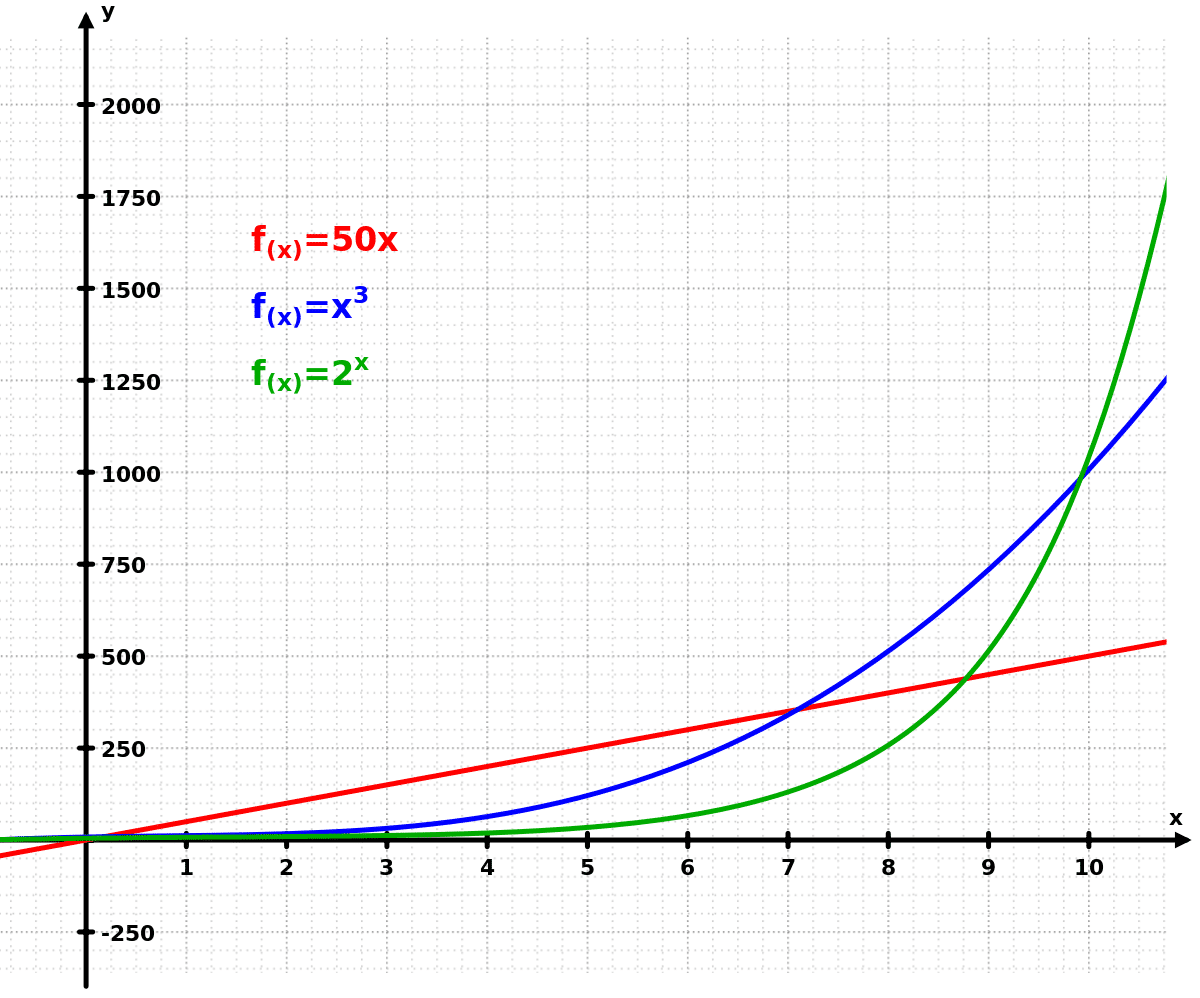An important dynamical process in biology is the growth of organisms and populations of organisms (i.e.bacterial growth). When studying and modeling living systems, generally the first approach is to measure the Exponential Growth and Decay experimentally. Then the researcher develops a reaction rate equation that functions as a model of the growth process. In all species on Earth, reproduction is an important parameter for survival. The success of a species to grow in size (population) is related to the number of individuals in the population. Population growth of bacteria is a relatively simple model, such as in the Petri dish (alternatively known as a Petri plate or cell-culture dish), a shallow transparent lidded dish that biologists use to culture cells, such as bacteria, fungi or small mosses. It is the most common type of culture plate. Bacterial populations increase rapidly during low bacterial densities in a nutrient rich environment. The bacterial growth occurs by cell division and so the time required for a cell to mature and divide is approximately the same to form two cells, etc. For this reason, the bacteria growth rate can serve as a basis for a simple discrete dynamical system model that introduces key components for modeling living systems. As the experiment of bacterial growth is started, we begin to look at the plot of bacterial density or change in density versus time. A plot of the population growth indicates the density increases faster and faster as time progresses, similar to what is shown in the figure below.

When looking at the data, analyzing the population change per unit time, it does not resemble a linear system i.e. f(x) = 50x. The data looks more like an exponential system, for example f(x) = x^3 or f(x) = 2^x, etc. It turns out that if a function is exponential, as many bacterial growth models are, the rate of change of a variable is proportional to the value of that variable which can be written in differential form as dy/dt = ky (where y is the concentration, k is the proportionality constant, and t is time). This is where Calculus comes in handy. Note there are many parameters and assumptions that go into the derivation of the rate equation. The reaction may be multi-step, or a 1st order or 2nd order etc reaction. A rate equation can also have an undefined reaction order with respect to a reactant if the rate is not simply proportional to some power of the concentration of that reactant. The theory of rate equations may also be generalized to understand biological chemistry to describe kinetics in systems involving biological cells. [1]
The bacterial growth system may be represented by a simple equation (dy/dt = ky) in differential form to illustrate, and by integration we get the formula y = C*exp(kt), where C is the initial value of y, and k is the proportionality constant. Something to note, this equation y = C*exp(kt) is a very simplified model for predicting the bacterial growth, and would not be a very accurate model for the spread of covid-19. There are many factors that go into the model for covid-19, researchers need to track mutations in the disease, and additional parameters such as quarantines, isolated people, and those who refuse to isolate themselves. Because of these things specifically, the models currently being used are not very good for predicting the disease’s progression. Researchers [2] believe if they are able to correctly account for the measures being put in place (i.e. policies, steps to prevent the spread, etc) they would be able to build a better model. In addition to this, obtaining accurate data on the spread of the virus is extremely difficult during an ongoing pandemic where vast numbers of people may become infected each day or governments are falsely reporting the numbers. Note how in our simplified mode, the differential equation naturally leads to the exponential function e, and this is used when modeling continuous growth systems that occur in populations such as bacteria growth, or radioactive decay, etc. We can think of the exponential function e as a universal constant representing how fast you could possibly grow using a continuous process. In the case of the spread of covid-19, there are many factors that enter into the rate of infection which may slow or accelerate the spread.
References
- Grima R, “An effective rate equation approach to reaction kinetics in small volumes: theory and application to biochemical reactions in nonequilibrium steady-state conditions,”J Chem Phys. 2010 Jul 21;133(3):035101. DOI: https://doi.org/10.1063/1.3454685
- Rashad Eletreby, Yong Zhuang, Kathleen M. Carley, Osman Yağan, H. Vincent Poor, “The effects of evolutionary adaptations on spreading processes in complex networks,” Proceedings of the National Academy of Sciences, 2020; 117 (11): 5664 DOI: http://dx.doi.org/10.1073/pnas.1918529117
Once we have developed a model, we see how well the model matches the data. The validity of a model, however, is only established after multiple uses in the laboratory and critical examination of the forces and interactions that lead to the representative differential equations. Models also change due to differing conditions, types of growth systems we are trying to study, etc. An analogy that comes to mind is what we see in the history of man’s model of the universe and how it has changed from the belief that Earth is the center of the galaxy. As we learned more, this model changed to the Copernican model where the sun is the center of the galaxy, and finally when we have enough empirical data we realize the sun is but a single star among some 200 billion in a galaxy, and the surprisingly recent realization (Hubble, 1923) that our Milky Way galaxy is but a single galaxy among an enormous universe of galaxies. Models change with our understanding, and remembering what we have already done, what we once proposed, to what we have today, helps facilitate the learning process. Note also, returning to the bacterial growth model problem, our model needs to be compared to the complete set of data, for example, different growth times (i.e. longer times) we may lead to the development a new model that will then account for the decrease in the rate of growth as the population size increases (i.e. bacterial food sources runs out, or there is a rate limiting step of the reactant “food” due to the population consumption rate after a certain size). These factors and more may be why the numbers coming out of the growth models are all over the place. Note the discrepancy in the reported numbers being predicted from the various growth models, they’re kind of all over the place. (Read Article Here) For example, the Centers for Disease Control and Prevention Model suggest approximately 200,000 Americans will die from this disease according to the NY times. (Read Article Here). Whereas, the Imperial College of London reports that 2.2 million Americans will die from this disease. (Read Article Here) The reason is every variable is dependent on a number of choices and there is a knowledge gap that occurs when a new virus begins to spread (i.e. how exactly does the virus spread, etc). The model is not based on a simple petri dish study, but is world wide and has regional differences, peoples, and cultures that may influence the infection rate (i.e. some cultures or people do not wash their hands after bathroom use, etc.).
The Spiritual insights that we are reminded of in relation to this type of research is related to sin, once sin begins, the body wants more and more and more. The growth rate of sin is limited to the body’s ability to perform and by one’s own imagination. The spread of sin is world wide, and may even be transmitted from person to person in the sense of what the Torah describes according to Shemot / Exodus 34:6-7, Devarim / Deuteronomy 5:8-10, and Vayikra / Leviticus 26:39.
Shemot / Exodus 34:6-7
ו וַיַּעֲבֹר יְהוָֹה | עַל-פָּנָיו וַיִּקְרָא יְהוָֹה | יְהֹוָה אֵל רַחוּם וְחַנּוּן אֶרֶךְ אַפַּיִם וְרַב-חֶסֶד וֶאֱמֶת: ז נֹצֵר חֶסֶד לָאֲלָפִים נֹשֵֹא עָוֹן וָפֶשַׁע וְחַטָּאָה וְנַקֵּה לֹא יְנַקֶּה פֹּקֵד | עֲוֹן אָבוֹת עַל-בָּנִים וְעַל-בְּנֵי בָנִים עַל-שִׁלֵּשִׁים וְעַל-רִבֵּעִים: 34:6 Then the Lord passed by in front of him and proclaimed, ‘The Lord, the Lord God, compassionate and gracious, slow to anger, and abounding in lovingkindness and truth; 34:7 who keeps lovingkindness for thousands, who forgives iniquity, transgression and sin; yet He will by no means leave the guilty unpunished, visiting the iniquity of fathers on the children and on the grandchildren to the third and fourth generations.’ (NASB)
Devarim / Deuteronomy 5:8-10
ח לֹא-תַעֲשֶֹה לְךָ פֶסֶל כָּל-תְּמוּנָה אֲשֶׁר בַּשָּׁמַיִם מִמַּעַל וַאֲשֶׁר בָּאָרֶץ מִתָּחַת וַאֲשֶׁר בַּמַּיִם מִתַּחַת לָאָרֶץ: ט לֹא-תִשְׁתַּחֲוֶה לָהֶם וְלֹא תָעָבְדֵם כִּי אָנֹכִי יְהוָֹה אֱלֹהֶיךָ אֵל קַנָּא פֹּקֵד עֲוֹן אָבוֹת עַל-בָּנִים וְעַל-שִׁלֵּשִׁים וְעַל-רִבֵּעִים לְשֹֹנְאָי: י וְעֹשֶֹה חֶסֶד לַאֲלָפִים לְאֹהֲבַי וּלְשֹׁמְרֵי מִצְוֹתָו [מִצְוֹתָי] : 5:9 ‘You shall not worship them or serve them; for I, the Lord your God, am a jealous God, visiting the iniquity of the fathers on the children, and on the third and the fourth generations of those who hate Me, 5:10 but showing lovingkindness to thousands, to those who love Me and keep My commandments. (NASB)
Vayikra / Leviticus 26:39
לט וְהַנִּשְׁאָרִים בָּכֶם יִמַּקּוּ בַּעֲוֹנָם בְּאַרְצֹת אֹיְבֵיכֶם וְאַף בַּעֲוֹנֹת אֲבֹתָם אִתָּם יִמָּקּוּ: 26:39 ‘So those of you who may be left will rot away because of their iniquity in the lands of your enemies; and also because of the iniquities of their forefathers they will rot away with them. (NASB)
Note how the punishment that comes to the subsequent generations (to the children) are to those who hate the God of Israel. We are told that when the sins of the fathers are visited upon the children, it is because the children have learned the sins of their fathers and are being very sinful, even more so than their parents. The Hebrew word most often translated as “sin” is the word chata’ah (חֲטָאָה), meaning “missing the mark,” which is analogous to an archer missing his target when shooting an arrow. There are other words in Hebrew that convey sin in a different way, such as the word pesha (פֶּשַׁע), which is a willful transgression done to spite God. This word contains the concepts of defiance, rebellion, and a casting off of God’s authority. In the English translations, pesha is translated as “transgression.” Another word for sin is the word avon (עָוֹן), translated as “iniquity” in the English Bible. Avon is connected with the idea of perversion, or twisting and distorting of the will of God for selfish ends. In the sin of Sodom and Gomorrah (Parashat Vayera) we are given details from the prophet Ezekiel who said “Behold, this was the guilt of your sister Sodom: she and her daughters had arrogance, abundant food, and careless ease, but she did not help the poor and needy. Thus they were haughty and committed abomination (תּוֹעֵבָה) before me; therefore I removed them when I saw it.” (Ezekiel 16:49-50) The Apostolic Writings describes Sodom as “a fearful example of the everlasting fire of retribution” (Jude 1:7) and as the destructive result of spiritual anarchy, lawlessness, deviancy, perversion, and trauma. (2 Peter 2:6-10) Note how sexual sin is one of those things that very closely parallels the bacterial growth by reason of the ever increasing lust of the flesh. This is drawn out in the word “sodomy” which is descriptive of any form of violence, perversion, exploitation, or lawless expression of sexuality. Sodomy describes the deviency of sexual sin, defiant, immorality that celebrates its pleasure, adultery, fornication, sexual perversion, pornography (lust of the eyes), covetousness, gluttony, arrogance as in idolatry, anger (rage), worshiping the flesh and this world, and so on, all of which leads to death. All of these things, sinfulness, leads to a traumatized heart and soul, and all we can do is seek the God of Israel, and Yeshua the Messiah, asking for deliverance in the name of Yeshua to turn from these things!
Yeshua illustrated the idea of teshuvah (i.e., תְּשׁוּבָה, repentance to God) by telling the story of the “prodigal son” (see Luke 15:11-32). In the story, the son after having squandered his father’s inheritance, decided to return home, full of shame and self-reproach. We are told according to the story that “while he was still a long way off, his father saw him and was filled with compassion for him; he ran to his son, threw his arms around him and kissed him.” What this reveals to us is how the father was out looking for his son to bring him home because of the great love that he had for him regardless of the amount of sin he had committed. The father then ordered a celebratory meal in honor of his lost son’s homecoming. When his older brother objected, the father said, “We had to celebrate and be glad, because this brother of yours was dead and is alive again; he was lost and is found.” This parable reveals to us the process of teshuvah in the sense of returning (shuv) into the arms of our Heavenly Father. Paul wrote that God sees us while we are still “a long way off.” (Romans 5:8) and how God passionately desires for us to come to Him in the name of His Son Yeshua so we will be forgiven. Note also how the parable of the prodigal son, the father slaughters the fatted calf for the son. See the parallel in the Son (Yeshua) who died for our sins. There are many ways Yeshua drew a parallel to himself, that He come to seek and save the lost (Luke 19:10) and how he was the shepherd who went to seek out that one lost sheep (Luke 15:3-7) and to the one who lost a coin and diligently searches for us and then when finding rejoices and celebrates. (see Luke 15:8-10)
Notice another parallel here in how we are being held captive in a sense due to the covid-19 virus. We are told not to travel, to stay at home, to distance ourselves from others, and to take extra measures to sanitize, wash, and not touch our eyes, nose, and mouth in order to prevent the spread of the virus. This imagery draws in a biblical metaphor of how God seeks and saves the lost from the power of the evil one. The God of the Universe, the Creator, left the heavenly realms to ransom us from captivity to sin. The prophet Isaiah said in Isaiah 59:15-16, 59:15 Yes, truth is lacking; And he who turns aside from evil makes himself a prey. Now the Lord saw, And it was displeasing in His sight that there was no justice. 59:16 And He saw that there was no man, And was astonished that there was no one to intercede; Then His own arm brought salvation to Him, And His righteousness upheld Him. (NASB) Note how the Lord God sent His Son to save the world from the power of the evil one. (see Hebrews 2:14 and 1 John 3:8) This is the good news of the Gospel Message, the Lord God sending His Son so by faith in Him we receive the Holy Spirit of God to empower us and set us free. Sacrificial love was what rescued us from the evil one (Matthew 12:29). In Isaiah 53 we are told that our transgressions were taken up. Yeshua was wounded for our transgressions (pesha) and crushed for our iniquities (avon), and bore the sin (chata’ah) for many. For those who place their faith in Him and in His sacrificial death, receives an offering that brings atonement before the God of Israel, our Father in Heaven. We are given peace, joy, and mercy, and for this we are able to run to the loving arms of our Father in heaven because of His Son and the gift of life that He has given us! During this time of the Passover festival, we must remember that the Lord is for us and not against us. He died while we were yet sinners (Romans 5:8), and He came to rescue us, to set us free, and to deliver us. Nothing can separate us from the love of God in heaven. (Romans 8:31-39) Abraham rejoiced to see the day of the Messiah, and he believed God, and as in the case of the Akeda, God Himself provided the sacrifice. (Bereshit / Genesis 22:8, John 8:56) May we be like Abraham, who believed the promises of God, as we believe in the Messiah Yeshua and all that is written of Him!









